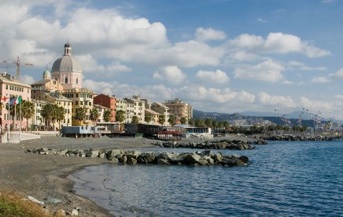Since Christopher Columbus walked the stone streets of Genoa, Italy, visitors have experienced a peculiar sensation while exploring.
Vertigo.
Genoa -- sister city to Columbus since 1955 -- rises 1,000 feet from its harbor to the foothills of the Apennine Mountains. Tourists negotiate steps and hillsides to reach better vistas or to see the town's magnificent churches and palaces.
Then, something catches the eye: a bit of architectural frieze or bas-relief, perhaps. Visitors look up.
Mark Twain described the experience of gazing up from Genoa's darkened streets, beholding the sky "like a mere ribbon of light far above your head."
Others say the heavens seem strangely within reach. Far becomes near. Up becomes down. Even a sure-footed traveler might need to steady himself against a nearby wall or statue.
Genoa residents themselves may seem a bit off-kilter these days after completing a dizzying array of renovations and new construction. All the fuss is to prepare for the city's stint as the European Capital of Culture this year.
The coveted designation by the European Union promises to snag travelers who might have overlooked Genoa for more popular Italian destinations.
Citizens have polished the town, unveiled new museums, restored palaces and planned more than 100 cultural events for the year.
Festivals will celebrate everything from traditional Italian music to Argentine tango. Regattas will ply the Gulf of Genoa. Theater troupes will stage productions throughout the city.
And Genoa will reveal itself as a City of Art, a designation it strove for centuries ago.
Via Garibaldi -- a Rodeo Drive for 17th-century Genoese -- is lined with palaces turned museums. Several have networked to display an impressive array of art by masters such as Peter Paul Rubens, Anthony Van Dyck, Caravaggio and others.
Much of the collection was hung first in the city, thanks to grandiose Renaissance families who tried to outdo one another by commissioning the works. Art lovers can feast their eyes upon Rubens' famous Palaces of Genoa at Palazzo Ducale this spring. The collection of works made the city famous.
More than art, Genoa is famed for its seafaring achievements. The city's Old Port -- or Porto Antico -- has been transformed from a gritty industrial area to a center for maritime exploration.
The new Museum of Sea and Navigation takes visitors on a virtual voyage from the high Middle Ages to modern times, incorporating 17th- and 19th-century buildings within its structure.
Glass-walled, passageways offer extraordinary views of the city.
The area's aquarium, the largest and most modern in Europe, offers a glimpse of what lives beneath the sea.
The great navigator himself is said to have grown up at the site of the Columbus House, a small and lonely stone structure outside Porta Soprana. No matter that the building is an 18th-century reconstruction and that many scoff at its claim to be the spot where Columbus' father toiled as a weaver.
To experience the essence of life in Columbus' day, one need only venture back into the Old City.
Old Genoa is one of Europe's largest medieval areas, containing almost 100 acres of architecture occupied since the Middle Ages.
Within its labyrinth of alleys, the cries of street vendors echo off centuries-old walls. The aroma of coffee mingles with that of pesto, which is said to have originated in the region.
Humble homes reside among elaborately painted churches and palaces. One can chat with residents going about the business of daily life.
Follow the streets a bit farther and the old port and gulf waters break into view.
From here, it's clear why Genoese have been sailors and merchants throughout history. Genoa is a crescent of land wedged between mountains and sea. Its medieval structures fill the void between. Modern buildings cling to surrounding mountains. A distinct line seems to separate the two.
Historically, residents had two places to go to stake new claims: up the hillsides or out to sea. The lapping waters on the old port docks -- even today -- issue an invitation. Many have found the call too great to resist.
If you go
GENOA, ITALY
Columbus' sister city plans a year of festivities to celebrate its designation as the European Capital of Culture.
GETTING THERE
* Several international airlines offer connecting flights into Cristoforo Colombo International Airport in Genoa.
Passengers flying into Milan can take a train to the city.
For information about flights, visit www.airport.genova.it/english/index.htm or contact a travel agent.
BEING THERE
* For more information about events celebrating Genoa's year as European Capital of Culture, visit www.genova-2004.it and click on "English" to translate.
* For information about the "The Age of Rubens: Genovese Homes, Patrons and Collectors," visit www.palazzoducale.genova.it.
* To learn more about the Aquarium of Genoa, visit www.acquariodigenova.it.
* For general information about Genoa, visit www.comune.genova.it.
Source: Robin Chenoweth
This article was published January 18, 2004, in the Columbus Dispatch.
Story copyright Columbus Dispatch.




